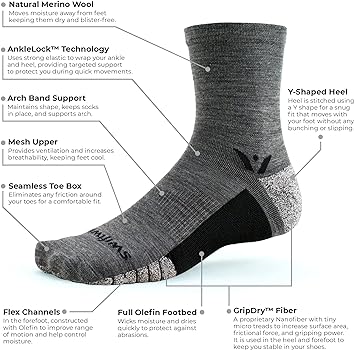Cooling hiking socks are designed to manage moisture and regulate foot temperature. They help prevent overheating during strenuous activities.
Exploring the great outdoors challenges body and spirit, especially when trekking through varied terrains under the beaming sun. To ensure comfort and enhance performance, cooling hiking socks are crucial. Crafted with advanced fabrics and ventilation technology, these socks wick away sweat, keeping feet dry and cool.
They typically feature breathable materials like merino wool blends, which offer temperature control, odor resistance, and durability. This combination makes cooling hiking socks an essential gear for hikers to tackle trails confidently. They’re versatile in nature and suitable for different hiking conditions, from arid deserts to humid forests, providing a shield against blisters and discomfort. With the right pair of cooling hiking socks, adventurers can focus on the path ahead, enjoying every step of their journey.

Credit: www.kosha.co
Why Cooling Hiking Socks Matter
Imagine walking miles with sweaty feet. Not fun, right? Cooling hiking socks keep your feet dry and comfortable. This can help you walk longer and enjoy more.
The Role Of Socks In Hiking Comfort
Hiking socks do more than you think. They help your shoes fit better. They also protect your feet from blisters. With the right socks, your feet feel good even after long hikes.
- Cushioning: They pad your feet.
- Support: They give your arches a gentle hug.
- Moisture-wicking: They pull sweat away from your skin.
- Breathability: They let your feet breathe.
Heat And Friction: Feet’s Worst Enemies
Hot feet swell and sweat, leading to friction. Friction causes blisters. Cooling socks reduce heat and sweat, keeping your feet happy.
| Feature | Benefit |
|---|---|
| Cooling Fibers | Lower feet temperature |
| Mesh Zones | Increase airflow |
| Moisture Control | Less sweat means less blisters |

Credit: www.rei.com
Materials That Beat The Heat
When the trail heats up, your feet deserve the best defense. Cooling hiking socks are the unsung heroes of your outdoor apparel. The material of your socks is crucial in comfort and heat management. Let’s delve into the fibers and technologies that keep feet cool and dry, regardless of temperature.
Natural vs. synthetic Fibers
Merino wool and cotton are fibers that originate naturally. Classic choices. Wool is known for its breathability and natural antimicrobial properties. It helps regulate temperature, maintaining a cool feel in heat. Cotton is soft and comfortable but tends to retain moisture. For those who prefer natural materials, new blends offer improved moisture management.
On the other hand, plastic fibers such as polyester, nylon, and polyethylene are used. Spandex is engineered for high performance. They offer superior durability and quick-drying capabilities. Synthetics also excel in moisture-wicking, ensuring sweat moves away from the skin, which keeps feet dry and cool.
| Fiber Type | Features |
|---|---|
| Merino Wool | Temperature regulating, antimicrobial |
| Cotton | Soft, comfortable, less moisture-wicking |
| Polyester | Quick-drying, durable |
| Nylon/Spandex | Elasticity, excellent moisture-wicking |
Innovations In Moisture-wicking Technology
Socks crafted with cutting-edge moisture-wicking technology can elevate your hiking experience. Innovations in fabric design enable sweat to be pulled away from the skin and evaporated quickly. This means hikers can enjoy a cool, dry trek without discomfort. Here’s a look at breakthroughs in sock technology:
- CoolMax fabric: Utilizes specially engineered polyester fibers to improve breathability and moisture removal.
- Outlast technology: Originally developed for NASA, this material regulates temperature by absorbing, storing, and releasing heat.
- Dri-FIT technology: Expels sweat to the surface for faster evaporation, keeping your feet dry and comfortable.
Design Features Of Cooling Socks
The design Features of Cooling Socks stand out, making them hikers’ best friends, especially in warm climates. Precision-crafted with innovative materials and structured to optimize airflow, these socks help hikers stay cool and comfortable. Let’s dive deep into the specific design elements that set cooling hiking socks apart from the rest.
Mesh Zones For Enhanced Breathability
Keeping feet cool on hot trails is all about breathability. Cooling socks often feature strategically placed mesh zones. These zones act as ventilation windows, allowing air to flow freely. This means sweat can escape, and cooler air can circulate over the skin. What stands out in these mesh zones are:
- Finely knit patterns are located on the top and sides of the foot.
- Lightweight fabrics that don’t sacrifice durability for breathability.
- Design variations suited for different intensity levels and temperatures.
Padding And Support Systems
Comfort goes hand-in-hand with cooling. These socks offer padding where needed most—around the heel and toe areas. The key features include:
| Location | Function | Materials |
|---|---|---|
| Heel | Shock absorption | Memory foam, gel inserts |
| Toe | Impact protection | Reinforced fibers |
| Arch | Supportive fit | Elastic bands |
Not only does the padding provide comfort for longer treks, but it also supports foot anatomy. Arches get special treatment with bands or weaves that offer a snug fit, helping to prevent fatigue.

Credit: www.amazon.com
Picking The Right Sock For The Trail
Let the blisters and discomfort be a thing of the past on the trail. Finding the perfect pair of cooling hiking socks can transform your outdoor adventures. With the right sock snugly wrapped around your foot, you can easily tackle the toughest terrains and keep your soles blissfully cool. So, let’s focus on how to pick the quintessential sock for the trail.
Matching Socks With Hiking Terrain
Select socks based on where you’re walking. Rough terrains demand thicker socks for cushioning. Smooth trails allow for lighter options.
- Rocky Paths: Choose high-density, padded socks.
- Forest Floors: Opt for mid-level cushioning.
- Desert Hikes: Go for socks with sweat-wicking ability.
- Mountain Climbs: Select thermal-regulating socks.
Seasonal Considerations For Hikers
Seasons change, and so should your socks. Stay ahead of the weather.
| Season | Features |
|---|---|
| Spring | Moisture-wicking, breathable |
| Summer | Lightweight, cool-max fabrics |
| Fall | Insulated, moisture-wicking |
| Winter | Thermal, heavier cushioning |
Maintaining Your Cooling Socks
Regarding hiking, cooling socks can be your best friend on the trail. Keeping your feet comfortable and sweat-free makes all the difference on those long treks. But high-quality cooling hiking socks need proper care. In this post, we’ll dive into how to maintain your cooling socks, ensuring they’re always ready for your next adventure.
Best Practices For Washing And Drying
- Turn socks inside out before washing to remove all dirt.
- Use cool to lukewarm water and a mild detergent.
- Hand wash or machine wash on a gentle cycle.
- Rinse thoroughly to prevent soap residues.
- Air dry your socks; do not use a hot dryer.
Extending The Life Of Your Socks
- Always clip toenails before a hike to prevent tears.
- Rotate between multiple pairs to avoid overusing a single set.
- For persistent smells, soak in baking soda solution before washing.
- When not in use, fold socks together, not rolled or balled up.
By following these maintenance tips, your cooling hiking socks will stay in top shape, aiding your performance and comfort each time you hit the trails.
Top Picks: Cooling Socks For Hikers
Get ready to tackle any trail with the coolest feet around. In this section, we dive into the best cooling socks for hikers. These picks promise comfort and breathability on even the hottest hikes.
Top Picks: Cooling Socks For Hikers
The right cooling socks are a game-changer for avid hikers. Keep your feet fresh with socks That will remove sweat and allow your skin to breathe.
Reviews Of Popular Brands
| Brand | Material | Features | Price Range |
|---|---|---|---|
| ArcticDry | Merino Wool Blend | Moisture-wicking, Quick-dry | $10 – $20 |
| CoolMax Rambler | Cocona Fabric | UV Protection, Odor Control | $15 – $25 |
| BreezeBlockers | Mesh Zones | Maximum Ventilation | $18 – $30 |
What Hikers Are Saying
- “ArcticDry socks kept my feet dry on a humid trail!”
- “Wearing CoolMax, I forgot it was 90 degrees out.”
- “My feet stayed cool even in desert heat with BreezeBlockers.”
Frequently Asked Questions For Cooling Hiking Socks
What Are Cooling Hiking Socks?
Cooling hiking socks are designed to regulate foot temperature on the trail. They’re made with breathable materials and moisture-wicking technologies. This keeps feet cool, dry, and comfortable during long hikes, especially in warm weather.
How Do Cooling Socks Work?
Cooling socks use special yarns and weave patterns to enhance airflow. They wick away sweat and often have mesh zones for extra breathability. This combination helps to dissipate heat and reduce foot temperature while hiking.
Why Choose Cooling Socks For Hiking?
Choosing cooling socks for hiking helps prevent overheating and blisters. They provide comfort in hot conditions, allowing you to hike longer without discomfort. Plus, they can protect against foot fungi and odor.
Are Cooling Hiking Socks Quick-drying?
Yes, cooling hiking socks typically dry quickly. Their fabric composition allows for rapid evaporation of moisture. This helps keep your feet dry and reduces the risk of blisters.
Conclusion
Remember the importance of equipping your feet with cooling hiking socks as your adventure draws closer. They are crucial to your trekking ensemble, enhancing comfort and preventing blisters. Next time you trail-blaze, ensure your socks are as ready as you are.
Happy hiking!

